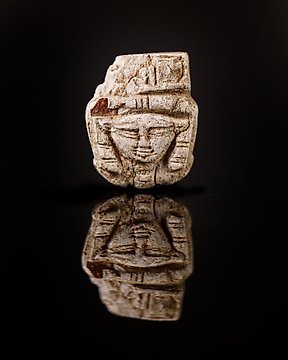
古埃及 Faience 哈索爾女神的護身符 - 2.2 cm
編號 84324721

編號 84324721

Fine amulet of the Goddess Isis.
Ancient Egypt, Late Period, 664 - 332 BC
Faience.
3.2 cm height.
Condition: Good condition.
Provenance: Private collection, Somerset, United Kingdom. 1970.
Description:
The goddess Isis, according to myth, is the daughter of Geb and Nut, and sister of Osiris, to whom she was also considered to be wed. As a deity she was referred to as: “Great mother goddess”, “Great Sorceress”, “Queen of the Gods”, “Fecundating Force of Nature” and “Goddess of Maternity and Birth”.
Osiris reigned in Ancient Egypt in peace, harmony and with wisdom. The Nile fertilized the earth and the crops were abundant. One day, Osiris set off to discover other civilizations and left his kingdom under the control of his wife, Isis. Set, his jealous brother, felt humiliated as he thought that he should rule rather than Isis. When Osiris returned, he was murdered by his brother. The goddess Isis, with the aid of other divinities like Nephthys and Anubis, sought out and found the cut-up pieces of her husband and put them together through special rites. After physical union with the god she conceived a child. The posthumous son of Osiris was to be the Horus-child, Harpocrates, who later, would wreak revenge on Set for his father´s murder.
As one of the main deities, Isis was worshipped in all periods in the history of Egypt, and it was in the final epoch that the largest temple was built to her on the island of Philae. The Greco-Roman world adopted her characteristics and associated them with Aphrodite and Venus. Another of her principal characteristics, her being considered “Mother of God”, would also be relevant in the cults influencing Catholicism and Orthodox Christianity.
Hathor is the goddess of the heavens, of love, happiness, music and dance. She is also the goddess protector of childbirth and children. This goddess is represented mainly as a woman with ears or the head of a cow, lyre-form horns and a solar disk. On occasion she is identified with other goddesses such as Sekhmet and Tefnut taking on the form of a lion, and with Bastet and Isis, with whom she is almost mistaken, and with whom she shares many legends and functions. She was one of the many goddesses who took on the role of the Eye of Ra, the female counterpart of Ra, and in this role she had a vindictive character which protected her from her enemies. Her benevolent side represented music, dance, happiness, love, sexuality and maternal care, and she acted as the consort of various male deities as well as being the mother of their children. These two aspects of the goddess exemplified the Egyptian conception of femininity. They crossed the frontier between the worlds, helping the deceased in transition to life after death.
The technique of lost wax casting is a sculptural procedure using a mould made from a prototype of the piece to be worked, and this prototype is usually made from beeswax. This is covered with a thick layer of soft material, usually clay, which then solidifies. Once this has hardened it is put in a kiln where the wax inside melts and leaks out through expressly made holes in the clay. In its place molten metal is injected and this takes on the exact form of the mould. To release the final piece the mould must be removed.
Notes:
- The piece includes authenticity certificate.
- The piece includes Spanish Export License (Passport for European Union) - If the piece is destined outside the European Union a substitution of the export permit should be requested, can take between 1-2 weeks maximum.
- The seller guarantees that he acquired this piece according to all national and international laws related to the ownership of cultural property. Provenance statement seen by Catawiki.